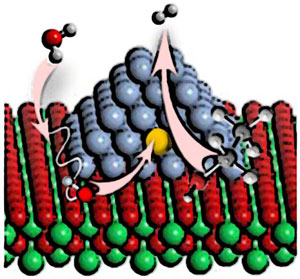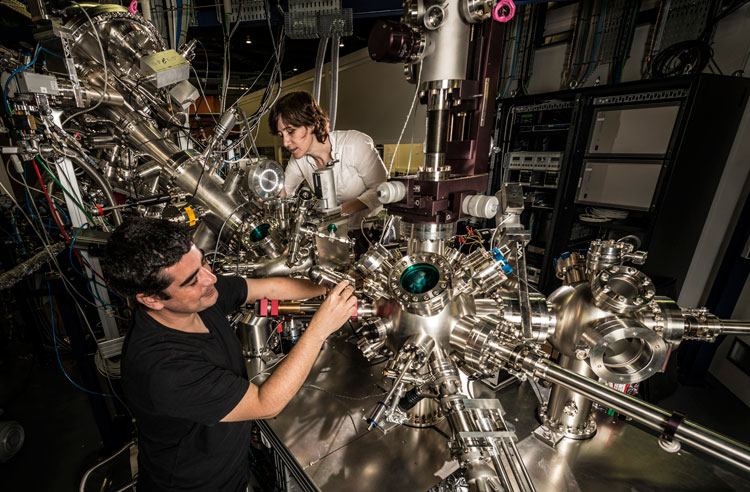Catalysts, which are used in 95% of industrial processes, can eliminate pollution from gases emitted by vehicles with combustion engines. They are substances that speed up chemical reactions and the human body has hundreds of them in the form of enzymes. From the point of view of energy, the role of a catalyst is to reduce the amount of energy required to trigger these reactions.
A team of researchers led by Jordi Llorca from the Nanoengineering Research Centre (CRnE) and the Institute of Energy Technologies (INTE)—both of which belong to the UPC—has studied how atoms move in a real catalyst and has demonstrated that they react differently depending on the type of support being used. The study, which is a very important step forward in the design of new catalysts with applications in the field of energy, involved the UPC doctoral student Núria Jiménez Divins, researchers Carlos Escudero and Virginia Pérez-Dieste from the ALBA Synchrotron and researcher Inma Angurell from the University of Barcelona (UB), who synthesised the nanoparticles that were used in the experiment.

Fig: Drawing of a ceria-supported metal rhodium-palladium nanoparticle. The ethanol and water molecules are absorbed at the interface between the nanoparticles and the support and they generate new reactive chemical species that make the rhodium and palladium atoms reorganise on the surface, change their oxidation state and thus facilitate the production of hydrogen.
Custom-made catalysts
The catalyst chosen by the researchers contained metal (rhodium and palladium) nanoparticles prepared by the Dendrimers and Molecular Polygons Group at the UB. The nanoparticles were fixed to a ceria support. This catalyst is very effective at producing hydrogen, a product that could replace fossil fuels before they are depleted and allow the current energy model to be changed in favour of a more sustainable and environmentally friendly one.
To learn how atoms and nanoparticles really behave in a catalyst and whether they always behave in the same way, the researchers used near ambient pressure photoemission (NAPP) at the CIRCE beamline. NAPP was developed by a research group led by Professor Miquel Salmerón in early 2000 at the Lawrence Berkeley National Laboratory in California, USA. One of a kind in Spain and available at only eight synchrotrons worldwide, the experimental NAPP station at the ALBA Synchrotron became operational in September 2013 and this was its first experiment.
Up until then, researchers had been able to ascertain what happens when the ethanol and water molecules are heated to 550 degrees Celsius, in the X-ray photoelectron spectroscopy chamber at the UPC's CRnE. Thanks to the ALBA Synchrotron, however, researchers were able to more accurately pinpoint the movement of atoms in the nanoparticles during chemical reactions (i.e. in operando) and found that these nanoparticles behave differently depending on the characteristics of the catalytic support, which can affect their composition, form and nanostructure.
As Jordi Llorca says, "the nanoparticles know where they are supported and react accordingly". This discovery, he explains, "paves the way for custom-made catalysts that are more efficient because they can be developed or adapted according to the process for which they are required".
In the case of hydrogen, the research team discovered that to produce it the atoms in the catalyst need to be in certain positions. These positions allow electrons to be exchanged between the metal nanoparticles and the ceria support appropriately when they break and form new chemical bonds to produce hydrogen.
In vehicles that use combustion engines (cars, motorcycles, planes, ships, etc.) with ceria-supported catalysts, new nanostructures could be designed or existing ones adapted to make them more energy efficient.

Researchers Virginia Pérez-Dieste and Carlos Escudero at NAPP endstation of CIRCE beamline.




